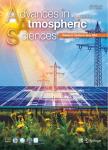Intercomparison of Precipitation Simulated by Regional Climate Models over East Asia in 1997 and 1998
Intercomparison of Precipitation Simulated by Regional Climate Models over East Asia in 1997 and 1998作者机构:School of Earth and Environmental SciencesSeoul National UniversitySeoulKorea Department of Geological and Atmospheric SciencesIowa State UniversityAmesUSAJr Department of Atmospheric SciencesYonsei UniversitySeoulKorea.School of Earth and Environmental SciencesSeoul National UniversitySeoulKorea
出 版 物:《Advances in Atmospheric Sciences》 (大气科学进展(英文版))
年 卷 期:2007年第24卷第4期
页 面:539-554页
核心收录:
学科分类:07[理学] 070601[理学-气象学] 0706[理学-大气科学]
基 金:the project of Prediction and Impact Assessment of Water Cycle with Climate Change in the Eco-Technopia 21 project funded by the Korean Government Ministry of Environment Korea Institute of Science and Technology Information the U S Department of Energy grants DEFG0296ER61473 and DEFG0201ER63250 the BK21 program of the Korean Government Ministry of Education
主 题:regional climate simulation summer precipitation variability extreme climatic event physical process
摘 要:Regional climate simulations in Asia from May 1997 to August 1998 were performed using the Seoul National University regional climate model (SNURCM) and Iowa State University regional climate model (***5/LSM), which were developed by coupling the NCAR/Land Surface Model (LSM) and the Mesoscale Model (MM5). However, for physical processes of precipitation, the SNURCM used the Grell scheme for the convective parameterization scheme (CPS) and the simple ice scheme for the explicit moisture scheme (EMS), while the ***5/LSM used the Betts-Miller scheme for CPS and the mixed phase scheme for EMS. The simulated precipitation patterns and amounts over East Asia for the extreme climatic summer in 1997 (relative drought conditions) and 1998 (relative flood conditions) were especially focused upon. The ***5/LSM simulated more precipitation than was observed in 1997 due to more moisture and cloud water in the lower levels, despite weak upward motion. In the SNURCM, strong upward motion resulted in more precipitation than that was observed in 1998, with more moisture and cloud water in the middle levels. In the ***5/LSM, weak upward motion, unchanged moisture in the lower troposphere, and the decrease in latent heat flux at the surface increased convective precipitation only by 3% for the 1998 summer event. In the SNURCM, strong upward motion, the increase in moisture in the lower troposphere, and the increase in latent heat flux at the surface increased convective precipitation by 48% for the summer of 1998. The main differences between both simulations were moisture availability and horizontal momentum transport in the lower troposphere, which were also strongly influenced by large-scale forcing.



